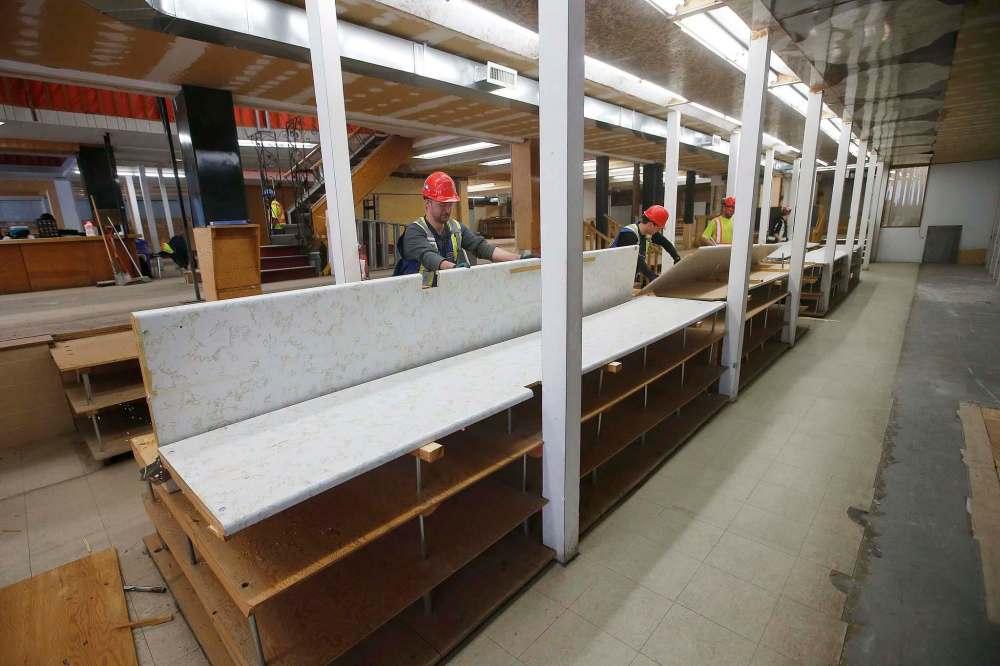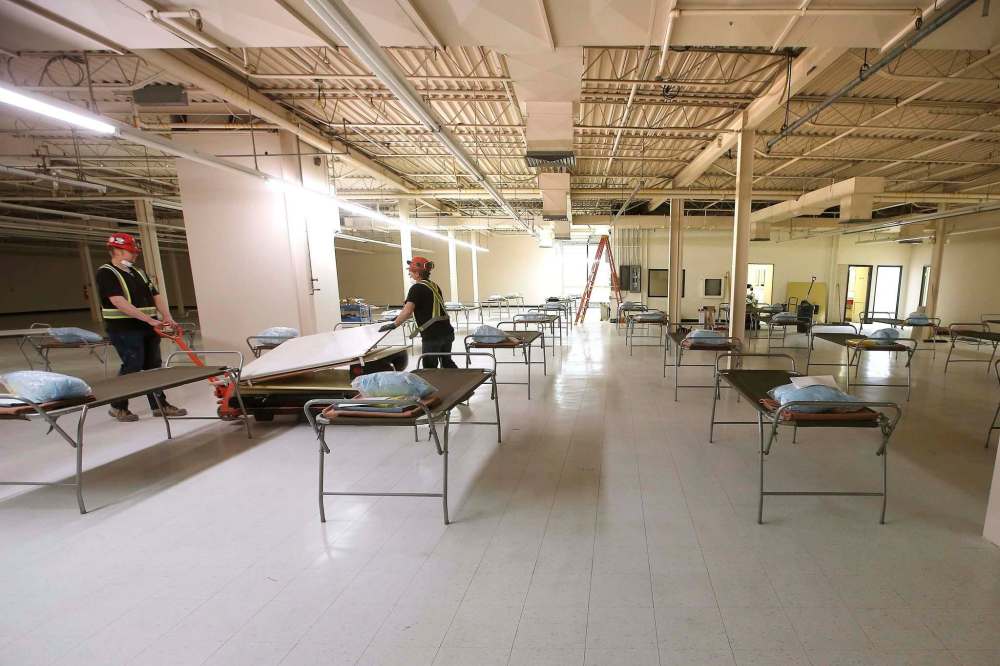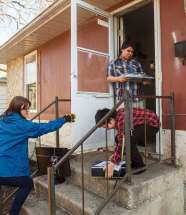Isolation-centre success a group endeavour Social agencies, governments and private donors band together to protect homeless during pandemic
Read this article for free:
or
Already have an account? Log in here »
To continue reading, please subscribe:
Monthly Digital Subscription
$0 for the first 4 weeks*
- Enjoy unlimited reading on winnipegfreepress.com
- Read the E-Edition, our digital replica newspaper
- Access News Break, our award-winning app
- Play interactive puzzles
*No charge for 4 weeks then price increases to the regular rate of $19.00 plus GST every four weeks. Offer available to new and qualified returning subscribers only. Cancel any time.
Monthly Digital Subscription
$4.75/week*
- Enjoy unlimited reading on winnipegfreepress.com
- Read the E-Edition, our digital replica newspaper
- Access News Break, our award-winning app
- Play interactive puzzles
*Billed as $19 plus GST every four weeks. Cancel any time.
To continue reading, please subscribe:
Add Free Press access to your Brandon Sun subscription for only an additional
$1 for the first 4 weeks*
*Your next subscription payment will increase by $1.00 and you will be charged $16.99 plus GST for four weeks. After four weeks, your payment will increase to $23.99 plus GST every four weeks.
Read unlimited articles for free today:
or
Already have an account? Log in here »
Hey there, time traveller!
This article was published 17/04/2020 (2064 days ago), so information in it may no longer be current.
Lack of funding, lack of space, lack of testing and little to no personal protective equipment.
That’s the reality the local homeless community was facing when it became clear it was just a matter of time before the novel coronavirus pandemic washed up in Winnipeg’s streets.
And so, the leadership of Winnipeg’s three shelters — Main Street Project, Salvation Army and Siloam Mission — got to work, scrambling to pool resources and advocate for the most vulnerable and at-risk segments of the population.
“This is the most complicated health care you can offer next to probably running an emergency room. And yet it’s the least funded, it’s the least considered, and in this pandemic, it wasn’t considered at all,” said MSP executive director Rick Lees.
“It’s only on the radar now because the three shelters came together and said, ‘This is not acceptable.’ And we yelled, and we put ourselves at risk when we did that, because sometimes it can cause an opposite reaction where people will say, ‘Alright, we’ll pull your funding.’”

Practically overnight, they have created a model for how other cities can manage the needs of the homeless amid the COVID-19 pandemic. And their work hasn’t gone unnoticed.
“We’ve had Thompson calling up, so we’re advising them on how to do this. We’ve had a call from Toronto. We’ve had a call from Calgary,” Lees said.
In the coming weeks, Winnipeg will have a broad system in place for the homeless in response to the pandemic, including expanded shelter facilities, a testing centre, isolation units, a quarantine space for those with the virus, and transportation to and from various locations.
Lees said the amount of work to pull it all together has been immense.
“The thing I want people to understand is setting up a shelter is a complex business. It isn’t opening a gym and throwing some mats on the floor and getting some volunteers and saying, ‘OK we’ve got a shelter,’” Lees said.
“If you want to do a shelter right, it’s a complicated business built around life safety, safety for staff, how people flow through a building, how you manage people who are in throes of addiction and dealing with mental health, and when you’re homeless sometimes people are very desperate.”
“This is the most complicated health care you can offer next to probably running an emergency room. And yet it’s the least funded, it’s the least considered, and in this pandemic, it wasn’t considered at all.” – MSP executive director Rick Lees
The progress on developing the model and getting preparations in place has been swift.
On April 10, the MSP — in partnership with Manitoba Housing and the Winnipeg Regional Health Authority — opened the doors to a low-barrier isolation facility for people awaiting test results.
So far, at least 11 people have spent time at the space, which is a formerly vacant six-storey apartment complex with 39 single units.
For weeks, MSP had been preparing to open such a facility despite not having secured a location or funding.
The agency finally managed to secure a property April 6. On April 9, the provincial government informed Lees they expected the site to be up and running the following day.

“That day from noon until midnight and later, we had furniture being delivered, people running up and down the stairs, an elevator guy fixing the elevator. We managed to get 10 rooms opened by 8:30 a.m. Friday,” Lees said.
Official titles and roles went out the window, according to Lees, who said it was an all hands-on deck effort.
That night, the agency’s budget manager purchased 10 TVs on his personal credit card for the rooms, the director of development helped set up and build furniture, and staff were asking to be assigned new tasks each time they completed one.
“It didn’t matter what your title was, we just had to get it done. That’s how something like this happens,” Lees said.
Clients at the facility get their own rooms, clothing, medical care, and three meals per day as they await their test results. So far, all of them have tested negative, Lees said.
Since the site opened, a silver lining of the crisis has emerged: At least two people have used their time in isolation to begin withdrawal from drug use and have been transferred into a withdrawal management program run by MSP.
“If you want to do a shelter right, it’s a complicated business built around life safety, safety for staff, how people flow through a building, how you manage people who are in throes of addiction and dealing with mental health, and when you’re homeless sometimes people are very desperate.” – Rick Lees
Lees said the agency hopes to use the isolation space as an opportunity to help people overcome their addictions or transfer them into transitional housing as opposed to having them return to life on the streets.
The Salvation Army has offered up its emergency response vehicle — a former ambulance the provincial government donated to the non-profit — to transport people from testing sites to the isolation facility.
MSP is also busy converting the former Mitchell’s Fabrics building on Main Street into a 120-bed quarantine facility for people who are homeless and have tested positive for the virus. That site is expected to be up and running within a month.
And by the end of the week, MSP is expected to open its new 170-bed shelter at 190 Disraeli Freeway, a former guitar strap manufacturing facility donated to the agency by owner Dan Levy.
Meanwhile, street outreach teams from multiple agencies have begun collaborating to provide around the clock coverage throughout the city, End Homelessness Winnipeg said in a statement.
A community testing site for the homeless will soon open at Thunderbird House, located near the city’s three shelters, which will limit the amount of space people have to travel to get tested.

None of this would have been possible, Lees said, without funding from the provincial and federal governments, as well as donations from a number of community partners and businesses.
This influx of support is allowing the agency to provide the quality of care they’ve wanted to for years.
But Lees said the scramble to prepare for the impact of the virus underlines the fact the sector has been underfunded for a long time, resulting in a critical lack of quality infrastructure.
Throughout history, pandemics have disproportionately impacted and spread through those without the ability to protect themselves. In Winnipeg, the homeless were overlooked during initial stages of preparation, Lees said.
“When someone living in Tuxedo is pounding the desk because they can’t get a ventilator for their parent or their grandparent, or the hospital beds are full, and they look around and realize they’re full of homeless people, because they get the sickest because they’re immunocompromised, then they’ll realize we should have looked after the homeless,” Lees said.
ryan.thorpe@freepress.mb.ca
Twitter: @rk_thorpe



Ryan Thorpe likes the pace of daily news, the feeling of a broadsheet in his hands and the stress of never-ending deadlines hanging over his head.
Our newsroom depends on a growing audience of readers to power our journalism. If you are not a paid reader, please consider becoming a subscriber.
Our newsroom depends on its audience of readers to power our journalism. Thank you for your support.






